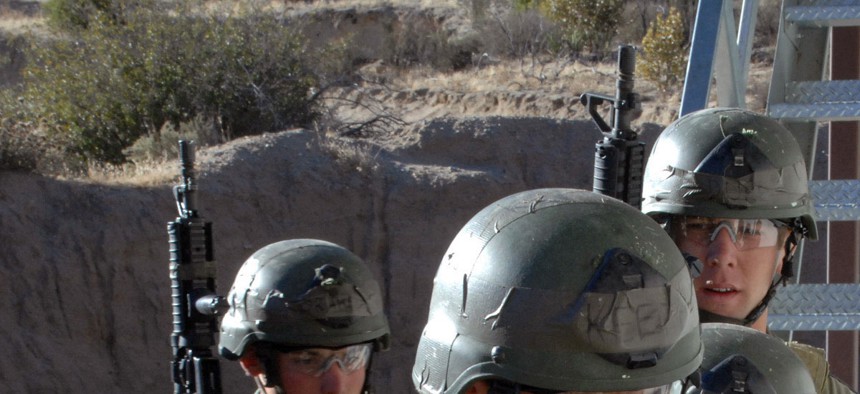
A team of four SEAL trainees prepare to breach a room during a training exercise. Navy Media Content Services by Petty Officer 2nd Class Christopher Menzie
Why the US Needs a Strategy To Counter 'Hybrid Warfare'
The Pentagon should expect more than a conventional fight in any military conflict with Russia, China, Iran or Syria. And it should start preparing for it immediately. By Robert A. Newson
The U.S. Army Special Operations Command (USASOC) released a timely white paper last month, titled “Counter-Unconventional Warfare (Counter-UW).” This white paper correctly argues that the United States requires, but does not have, a credible strategic-level ability to interdict and roll back external sponsorships of insurgent and separatist movements.
The Growing Threat of Hybrid Warfare
Counter-UW, to a large degree, is about responding to the increasing use of hybrid warfare. Hybrid warfare has been defined as a combination of conventional, irregular, and asymmetric means, including the persistent manipulation of political and ideological conflict, and can include the combination of special operations and conventional military forces; intelligence agents; political provocateurs; media representatives; economic intimidation; cyber attacks; and proxies and surrogates, para-militaries, terrorist, and criminal elements.
Hybrid warfare places a premium on unconventional warfare (UW)—defined in military doctrine as activities conducted to enable a resistance movement to coerce, disrupt, or overthrow a government. External sponsorship often provides the motivation, resources, and support to people attempting to destabilize international and regional security. Some examples of this strategy include the Russo-Georgian war of August 2008, Russia’s current activities in Ukraine, and potential future Russian moves in the Baltics, as well as Iran’s use of surrogates such as Hezbollah. Accordingly, a United States capacity for counter-UW is absolutely necessary.
What’s Different About Counter-Unconventional Warfare?
Counter-UW is distinct from counter terrorism (CT) and counter insurgency (COIN). CT operations tend to be short-term, time-sensitive, intelligence-driven (reactive) operations with immediately visible results; i.e., has the kill or capture been achieved or not? Counter-UW, by contrast, is protracted and proactive. The results are expressed in negative terms: what areas are not under insurgent control? What opportunities have been denied to them, and what objective has the enemy failed to achieve?
Meanwhile, COIN operations are designed to contain and defeat an insurgency while simultaneously addressing the root cause. As a result, COIN tends to generate a very large footprint and high U.S. signature. Counter-UW, on the other hand, is executed by a smaller force and is more narrowly scoped. It has a small footprint, a low signature, and is specifically designed to deny an adversary the ability to use surrogates as a path to strategic success.
Building upon the lessons learned from more than a decade of CT and COIN, U.S. special operations forces (SOF) can develop this military capability to deny adversaries the capacity to employ unconventional warfare to achieve strategic goals. USASOC is uniquely suited for counter-UW because of its combination of capabilities, including military information support operations (formerly known as psychological operations or PSYOPS), civil affairs, Special Forces (Green Berets), robust and scalable command and control capacity, and a growing “reach-back” capability in all these areas to support forward operations from the U.S.
More Than Special Operations Forces
While SOF will have the primary counter-UW role within a larger whole of government effort, hybrid warfare and counter-UW have implications beyond SOF. China’s pursuit of unrestricted warfare has not yet included the use of surrogates or para-military forces—unless you count the intimidating use of the Chinese Coast Guard —but their UW capabilities should not be discounted. The U.S. should expect more than a conventional fight in any military conflict with Russia, China, Korea, Iran, or Syria.
Hybrid warfare, on display now in regional conflicts, will one day be turned against the U.S. and our military forces. Counter-UW should be included in joint and service exercises, as well as operational and contingency plans. Additionally, the military services should explore how to integrate a supporting SOF counter-UW campaign within their broader operations.
An Uncertain Path Ahead
Counter-UW requires a whole-of-government approach and a comprehensive and integrated pursuit of political warfare, including economic sanctions, diplomacy, the use of surrogates, military and law enforcement support to partner nations, and strategic communication and information operations. The U.S. has not displayed a strategic whole-of-government capacity beyond CT, counter-narcotic, and counter-proliferation tactical operations coordinated by joint interagency task forces. A considerable effort and strong leadership will be required to create this capacity. This task is so enormous it may take congressional legislation to create a strategic-level national counter-UW capability.
Much depends upon the willingness of national leaders to commit to conducting protracted counter-UW operations in sensitive, hostile, and denied environments. Counter-UW requires early and long-term investment. Timely decisions—prior to a crisis—are needed, presenting a real problem. Since the end of the Cold War the U.S. has rarely invested in developing long-lead options like counter-UW. It should start now, immediately preparing counter-UW capabilities in eastern Europe and the Baltics to counter future Russian use of hybrid warfare.
It will be all too easy for institutional forces to argue against counter-UW activities and related preparation based on fears that they will be destabilizing, escalatory, or difficult to control due to the central role of surrogates. Regardless of the potential downsides of counter-UW, the alternative—allowing our adversaries strategic advantage through the unopposed use of surrogates and proxies—will always be the worse option.
This post appears courtesy of CFR.org.
NEXT STORY: The Air Force’s Quiet Energy Revolution




